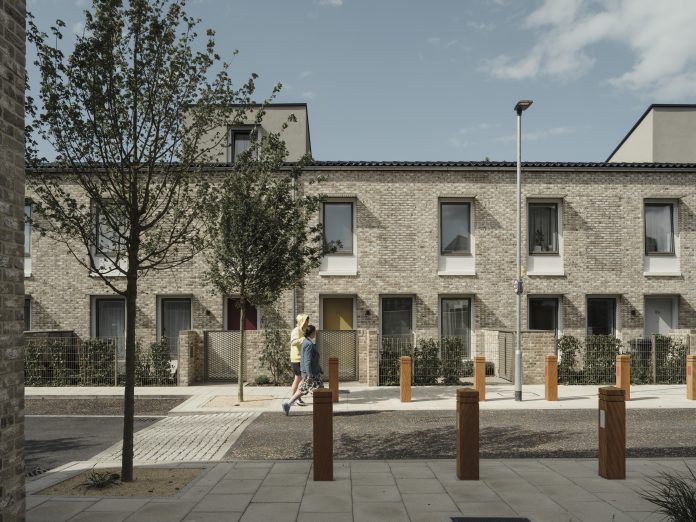In this article, TRADA looks at why the Stirling Prize-winning Goldsmith Street represents a big step forward for Passivhaus – and looks at the 2020 University Challenge to inspire students to create the next generation of low-carbon timber housing
When TRADA member Mikhail Riches’ Goldsmith Street won the 2019 RIBA Stirling Award, it marked a turning point for Passivhaus and demonstrated that it could be delivered to a restricted budget. The international building standard, which prioritises energy efficiency and dictates high levels of thermal comfort while requiring little energy for space heating and cooling, is reached through careful design, build and certification, and results in excellent measured and certified building performance.
Goldsmith Street, 100% Passivhaus
The notable thing about Goldsmith Street, a development for Norwich City Council, is that it is currently the biggest 100% Passivhaus, 100% social rented housing scheme in the UK. It had to use materials wisely and strategically in order to maximise its budget and required holistic working from the architects alongside the contractor, quantity surveyor, landscape architects, structural and M&E engineers to achieve this.
In the words of Tabitha Binding, TRADA’s university engagement manager: “The doors have been opened by Goldsmith Street to a new form of architecture that values materials for what they bring to a project and not just their aesthetics. The timber frame and cellulose insulation used in these homes have contributed to the speed, quality and performance of the build.”
Its Stirling Award win is evidence that the gap is closing between the perceptions of Passivhaus and otherwise.
Meeting the 2050 net-zero target
Certainly, the long-looming climate crisis, the recent uprising of child activists and the UK’s 2050 net-zero target must spur us into action – and Passivhaus has an active role to play. Over a building’s lifetime, the operational carbon, ie the emissions from energy-consuming activities such as heating, cooling, ventilation and lighting, have a larger environmental impact than the embodied carbon of the materials used to build it. It is essential, therefore, that we use resources for our buildings that are good for the planet and reduce how much energy we consume when we live in them. By extension, we have to understand our materials in order to use them wisely, efficiently and appropriately.
In the future, Passivhaus and variations of it will be more commonplace – the climate crisis demands this – and Goldsmith Street might be considered a role model for normalising it on a modest budget. Not only will Norwich City Council reap the rewards of a project that has considered both the longevity of the fabric and ease of building maintenance, but also the occupants will benefit from reduced energy bills, with guaranteed light, warm and healthy homes.
Designing low carbon timber housing
This is the thinking behind the TRADA University Challenge 2020 brief, which will ask students to design timber community housing that is low-carbon, energy and water efficient, climate-resilient, healthy and desirable. These students are our professionals of the future who will design, engineer, cost and construct our built environment that is required to be zero carbon by 2050 – if not before.
The use of timber is not prescribed by Passivhaus certification – it is material blind – but timber possesses inherent strengths that give it a natural advantage in such partnerships. These include acoustic and thermal qualities that yield high levels of thermal comfort and sound mitigation, as well as humidity moderation. This, together with timber’s remarkable ability to sequester carbon, leads TRADA and its members to believe that timber will have a significant role to play in the built environment in years to come.
Of course, the timber industry at large agrees that the only way forward is to encourage the next generation of architects, engineers and designers to learn about timber and become familiar with the resources they’ll need to design and build timber structures fit for purpose. The support for TRADA’s application to create an accredited Level 4 Timber Products Technician apprenticeship shows this across the board.
Encourage multi-disciplinary working
However, TRADA believes we must go one step further: we must encourage a culture of multi-disciplinary working which starts, much as Goldsmith Street did, from the beginning. We must also leverage knowledge from our current professionals and timber product suppliers, learning directly from their first-hand experience, encouraging greater interaction between academia, professionals and suppliers.
“The urgency of the climate crisis means that a multi-disciplinary approach to building design is not so much a school of thought as a matter of survival. Sustainable buildings cannot be one-off exemplars but must become the norm. The only way to achieve this is for all disciplines to work together with a common goal,” says Nick Grant of the Passivhaus Trust.
“Passivhaus gives us the necessary tools and common focus to achieve high comfort and quality with minimal energy use. Passivhaus is open and transparent and supported by a rapidly growing international community of practitioners. While refinement is always possible, Passivhaus works out of the box. We really don’t have time to reinvent the wheel.”
TRADA University Challenge
The TRADA University Challenge is unique in this respect. It will invite 60 students from UK universities to gather at Cardiff University’s School of Engineering Queen’s Buildings and split them into 10 multi-disciplinary teams of six, leaving them to compete to see who can design, cost and engineer the best low-carbon, energy- and water-efficient timber community housing in less than 48 hours. These teams will consistent of engineers, architects, architectural technologists, quantity surveyors and landscape architects, while pioneering design professionals and industry members will provide guidance and support. As such, it is an exceptional opportunity for students to gain real-life experience working with and in support of others in the industry.
TRADA is hopeful that this year’s competition will provoke a long-lasting passion and encourage the participating students to learn more about energy efficiency, indoor air quality and the subtleties of handling timber. Good luck to all involved!
The University Challenge 2020 could not take place without the kind sponsorship and support of major sponsors STEICO and Arnold Laver, sponsor Stora Enso, and supporters PEFC UK, Passivhaus Trust, WTTA and Wood for Good.
TRADA
Tel: +44 (0)1494 569603
Twitter: @TRADA_
LinkedIn: TRADA














